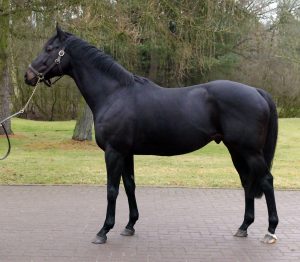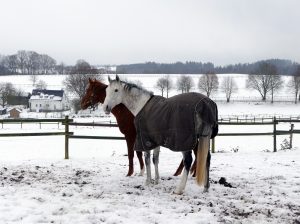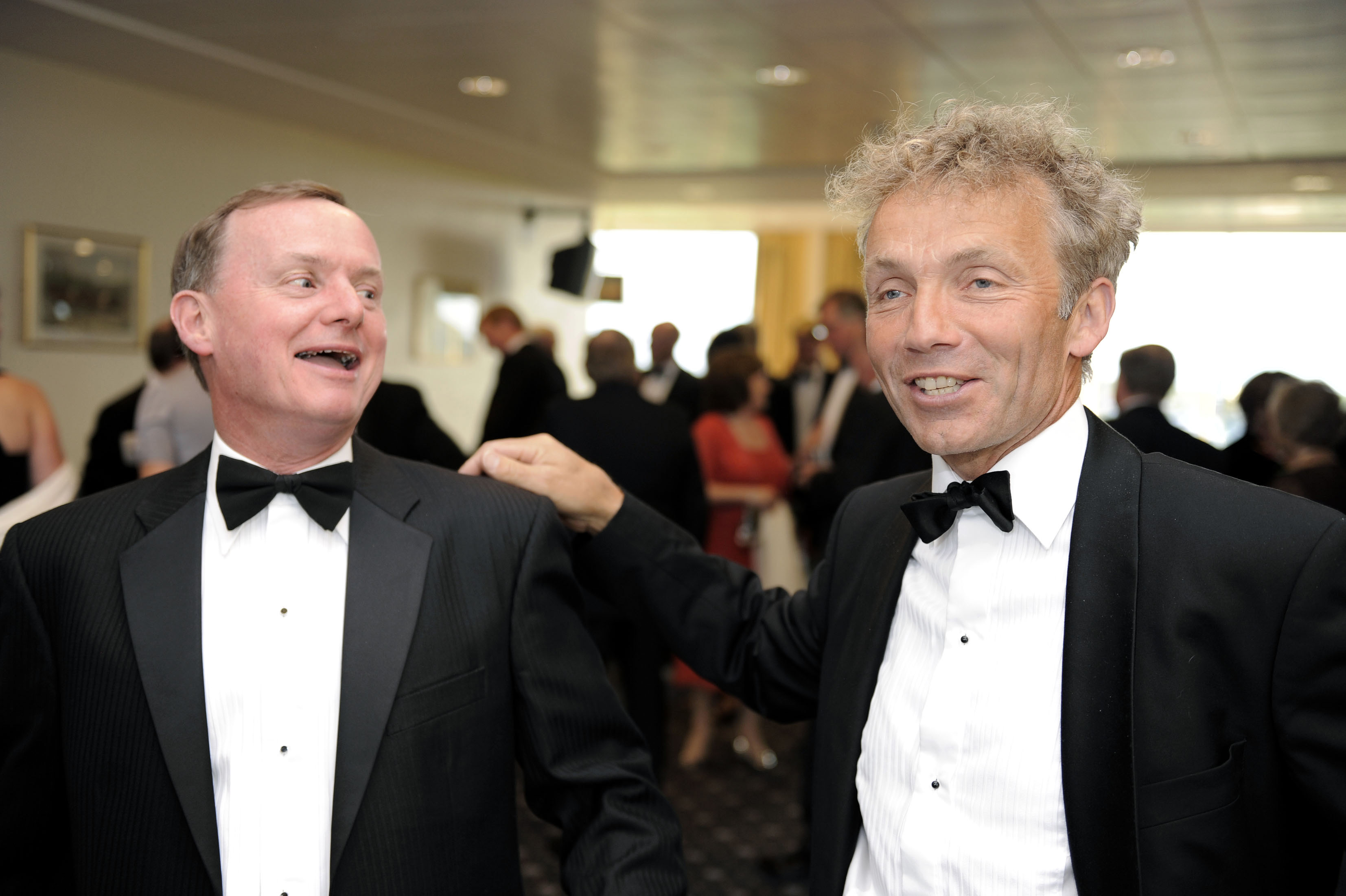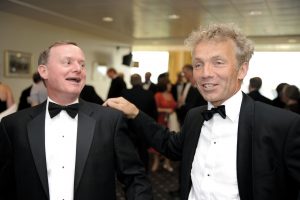It’s more than four years since Monsun died at Gestüt Schlenderhan at the age of 22. The influence of the dark brown stallion, who was blind for the last decade of his life, is still keenly felt in his native Germany, not just in the bloodlines of thoroughbreds but also through the wider recognition he brought his homeland as a breeding nation.
The sheer size of Germany, with its stud farms spread far and wide, makes it nigh on impossible for its promoters of thoroughbred breeding to emulate France or Ireland in attempting to host a showcase weekend for the country’s stallions, but Thoroughbred Owner & Breeder was fortunate to be able to call on the goodwill and expert knowledge of well-known breeder and consignor Philipp Stauffenberg to organise a bespoke tour of a number of stallion farms in early January.
Gestüt Fährhof
Our trip covered almost the entire length of Germany from north to south, with a detour out west, and started at Gestüt Fährhof. The stud will be familiar to many, not least through its association with Newsells Park Stud, which was bought in 2000 by Klaus Jacobs, the son of Fährhof’s founder Walther Jacobs. Nowadays, both farms, as well as Maine Chance Farms in South Africa, are owned by Klaus’s son Dr Andreas Jacobs.
This year is a significant one for Fährhof as its two young stallions, Maxios and Pastorius, are set to have their first runners. However, as important as it is for young sires to make a good early impression, thus prompting continued or increased support, the whizz-bang two-year-olds that have become so popular in Britain and Ireland are of less significance in Germany, where the first juvenile race isn’t until late May/early June and no Group 1 race is run at less than ten furlongs.
In words that will be music to the ears of those breeders who bemoan the dwindling popularity of middle-distance stallions, Fährhof’s Manager Stefan Ullrich explains: “It doesn’t really affect the popularity of a stallion if he doesn’t have many two-year-old runners. It’s much more important here to have a Derby runner – that’s what many of our clients want.”
Fährhof has a rich stallion history of its own via its homebred six-time German champion sire Surumu and his multiple champion son Acatenango.
As broodmare sire, Surumu was responsible not only for Monsun but also for the Fährhof-bred former reprobate Lomitas, whose ban from racing through his being difficult to load into the stalls, was lifted after he became the first high-profile beneficiary of Monty Roberts’ famous Join-Up method of breaking youngsters or dealing with difficult horses.

Maxios has been well supported at Fahrof and has his first runners this season
Monsun appears in the pedigrees of both the farm’s young stallions – as sire of Maxios and broodmare sire of Pastorius – and as the hunt continues for a proper Flat heir to the great stallion, many hopes rest with Maxios. He will not fail for lack of support. His breeder, the Niarchos family, has retained a major share and the near-black stallion, whose prowess over a mile to ten furlongs will enhance his appeal outside Germany, has been well supported, both by breeders and at the sales. He has six colts entered for the 2018 Investec Derby.
In contrast, Pastorius not only achieved the aim of many German breeders in winning the German Derby of 2012, but he was the first Group 1 winner and is now the first son at stud for the increasingly popular Soldier Hollow, whose rising prominence has gone a long way to filling a void left by Monsun’s death.
Pastorius is set to cover around 50 mares this season, which may be a small number for some British and Irish stallions but compares favourably to his own sire, who covered only 22 mares in his first book, while Monsun had only 28 foals in his first batch. It is worth remembering that they each produced a first-crop German Derby winner from these limited opportunities.
One other stallion who remains under the radar at Fährhof is Acetenango’s son Sabiango, whose two German Group 1 wins were followed by success in the Grade 1 Charles Whittingham Memorial Handicap in America. The fact that he raced on Lasix in the US means that he is affected by Germany’s strict rules on standing stallions – through he is allowed to stand at stud, none of his offspring qualify for the lucrative German premiums, rendering him understandably unpopular with breeders.
In common with a number of other major German breeding operations, Fährhof has its owns breaking and pre-training facility based on its 180-hectare estate and still receives an annual visit from Monty Roberts, who teaches the staff his Join-Up method. The yard is in the capable hands of Racing Manager Simon Stokes, an Englishman whose tenure dates back to 1994 and who played a significant role in the rehabilitation of Lomitas.
Gestüt Auenquelle
From Pastorius, we travelled next to see his sire, Soldier Hollow, at Karl-Dieter Ellerbracke’s Gestüt Auenquelle, the 17-year-old having been transferred there after spending his first four seasons at Gestüt Röttgen.
The British-bred stallion is a small horse with a big reputation: with just over 100 mares booked at the time of our visit, he will be the busiest stallion in Germany this year, though his book will be capped at 110 mares. He was also responsible for three of the five most expensive yearlings at the BBAG Yearling Sale last September, with international buyers of his stock including Jeremy Brummitt, the Hong Kong Jockey Club, Ralph Beckett, Matt Coleman and Peter Doyle.
“From covering 22 in his first year at stud, Soldier Hollow covered 70 mares in 2012 when he first arrived here and his first really big crop are two-year-olds this year,” said Ellerbracke, the President of BBAG and former Chairman of the German Owners’ and Breeders’ Association.
“I like to stand stallions who have proved themselves on the racecourse year after year. I would never stand a stallion who has not raced beyond two.”
In this regard, Ellerbracke has met his perfect match. Soldier Hollow, a son of the equally diminutive In The Wings bred at Car Colston Hall Stud, ran 31 times across six consecutive seasons for his owner Gestüt Park Wiedingen. He won a Listed race over a mile at two before winning a Group race in each of his following seasons, including four Group 1 contests in Germany and Italy.
Soldier Hollow’s good temperament is exemplified by the fact that hard-working Stud Manager Tanja Sramek allows us to wander through his stable with doors at each side and brings him out to parade in just a headcollar. He is now the sole stallion on the farm which stood the high-class sprinter Big Shuffle – who is immortalised in a near-lifesize fairytale painting in the hallway of Ellerbracke’s home – as well as the King George winner Doyen before his sale to Ireland’s Sunnyhill Stud.
Ellerbracke says: “Big Shuffle and Doyen I sourced myself. I was asked to stand Soldier Hollow and I was very happy to take him as he fulfils all my targets: he’s a very tough horse and a very honest horse who always fought to win. It gives me a lot of joy to have a third successful stallion now here at the farm.
“I’m overwhelmed by the response to him and never expected it. Big breeders are sending three or four mares and he has a number of mares coming from France as well as some from England.”
In Ellerbracke’s role as BBAG Chairman, he has welcomed the increasing international interest in Germany.
“BBAG was a club of German breeders and up until 15 years ago only German horses could be sold there,” he says. “Now we have some international shareholders in BBAG and the number has increased – first it was mainly French horses who came and now there are a few more from England.”
Gestüt Hof Ittlingen
Just as Big Shuffle’s image dominates Karl-Dieter Ellerbracke’s home, there’s no mistaking Gestüt Hof Ittlingen as the birthplace of the 1995 Japan Cup winner Lando, whose photos adorn many walls at the farm. He went on to sire seven Group 1 winners throughout his time both at his home stud and at Haras d’Etreham.
Owned by the President of the German Owners’ and Breeders’ Association Manfred Ostermann and his sister Janet Lewe-Ostermann, the Westphalian farm is home to 40 broodmares and their followers, as well as the homebred Group 1 winner Neatico and Lando’s multiple Group 1-winning son and 2002 Horse of the Year Paolini.
It is uncommon for the Ostermanns to sell their stock as yearlings – the 2013 Deutsches Derby winner Lucky Speed, now standing at Sunnyhill Stud in Ireland, being a rare example of ‘one who got away’. As one of the biggest breeders in Germany, their reluctance to sell means that they are also the biggest owner in the country, with around 60 horses in training, predominantly in Cologne with Waldemar Hickst and Peter Schiergen.
The most recent top-level winner in the Ittlingen red and white silks was Medicean’s son Neatico, who strongly resembles his broodmare sire Sadler’s Wells. The ten-year-old currently has his first yearlings on the ground, including a half-sister to the Group 2 Sky Classic Stakes winner Lauro.
The Ostermanns also bred Group 1 Preis von Europa winner Scalo, another son of Lando whom they stand at Haras du Logis St Germain in
Normandy.
Gestüt Schlenderhan
A whole book could be written on the history of Schlenderhan, which sits in the heart of the small town of Bergheim, not far from Cologne.
Founded in 1869 by Baron Simon von Oppenheim, the great-grandfather of the current owner Baron Georg von Ullmann, the stud is thus the oldest in the world to have remained constantly under the ownership of one family.
Of course it has become synonymous with Monsun, who was bred farther south at Gestüt Isarland but raced in Von Ullmann’s colours before making an indelible impression on the breed following his retirement in 1996. But Schlenderhan was already guaranteed more than a historical footnote as the breeder of the hugely influential broodmare Allegretta, a fifth-generation descendant of their homebred German Derby and Oaks winner Asterblute.
Allegretta may have been ‘culled’ at three, being sold from the stable of Sir Michael Stoute via Tattersalls to commence stud duties in America, but the blood of her female line still flows freely at Schlenderhan, while she has herself played a highly significant role in modern-day pedigrees, predominantly through her extraordinarily successful daughter Urban Sea.
Schlenderhan officially now stands just one stallion, Adlerflug, like Soldier Hollow a son of In The Wings but this one descending from the farm’s special dynasty as Adlerflug’s third dam Anatevka is also the dam of Allegretta. As well as hailing from one of the best stallion families in the business, Adlerflug also owns an important credential for the German breeding market – a domestic Derby victory.
Owned by a partnership which includes Fährhof, he has, however, spent his entire stud career at Gestüt Harzburg, but while that farm undergoes renovation Adlerflug has temporarily returned to stand at his birthplace, where it is expected that he will cover around 40 mares.
Just down the road, another two Schlenderhan homebred stallions have been entrusted to neighbour Gestüt Erftmühle, which is home to the veteran Tertullian – a grandson of Allegretta who shares his sire, Miswaki, with Urban Sea – and his young son Guiliani, from another top-class Schlenderhan family which produced Baron von Ullmann’s dual Group 1 winner Getaway.
“We always try to keep the old lines and even if they are not producing for some years we don’t give up – blood is blood,” says Schlenderhan’s General Manager Gebhard Apelt. “Our two original ‘A’ families – from Asterblute and Aubergine who were first and second in the German Derby in 1949 – are still in existence at the farm.”
Apelt is quick to acknowledge Monsun’s influence in keeping Schlenderhan to the fore, saying: “He lived on an island – he was a complete outcross. If he hadn’t been here we would be bankrupt. When I saw his first two-year-olds in training and they were such easy gallopers I knew he would have a good chance.
“He had the champion two-year-old Sommernacht in his first crop of only 28 foals. But it is important to remember that they got so much better at three and older, and it was important not to push them too hard too soon.”
The farm alternates between selling colts and fillies at the yearling sales, and those that are retained are trained ‘at home’ by private trainer Jean-Pierre Carvalho. The Frenchman may have lost last season’s Melbourne Cup winner Almandin – who grew up in the same paddock as the 2014 Cup winner Protectionist – to Australia’s Robert Hickmott, but among the Classic hopes in his barn this year is the filly Tusked Wings, by Adlerflug out of a half-sister to Tertullian and thus inbred 4×4 to Allegretta. As Apelt says, blood is blood.
Gestüt Röttgen
Just a stone’s throw from Cologne’s industrial suburbs lies the walled utopia of Gestüt Röttgen, owned in trust since the death in 1985 of Maria Mehl-Mulhens, who is remembered in the naming of the Mehl-Mulhens Rennen (German 2,000 Guineas) at the farm’s local racecourse.
Within those walls, which have stood since 1924, lies 300 hectares of land for the stud’s broodmare band, training centre and stallion yard, which is currently occupied by Sven Hansen’s Prix du Jockey-Club winner Reliable Man and newcomer Protectionist.
Reliable Man’s dual-hemisphere success in his racing days has led to him being a popular shuttler. The grey has recently returned from covering 160 mares at New Zealand’s Westbury Stud but he will have a quieter time in Germany, where he is likely to cover around 50.
Having stayed in Australia for an unsuccessful season after his Melbourne Cup victory, Protectionist was reunited with Andreas Wohler to win a further two Group races last year. Hailing from the high-class Wildenstein family of Pawneese, and as one of the last sons of Monsun to retire to stud, he is an appealing addition to the German ranks for 2017.
Markus Klug is the man entrusted to train the Röttgen homebreds but he is not retained solely as a private trainer, with horses from Gestüt Wittekindshof, Ittlingen and Maine Chance Farms among those currently in his 100-strong team. Klug’s most recent major success came for another outside breeder, Gestüt Gorlsdorf, whose Sea The Moon won the German Derby for the stable in 2014.
Among those to have spread the Röttgen name to a wider audience in Europe are Star Appeal, who became the first German-trained horse to win the Prix de l’Arc de Triomphe, and Wild Coco, winner of the Group 2 Park Hill Stakes for Sir Henry Cecil in the farm’s colours.
Despite its proximity to a major city, it’s easy to see how racehorses thrive in the calm environment of Röttgen. Pleasingly devoid of mod-cons, it instead offers kilometres of quiet forest tracks and a vast, cathedral-like indoor school for starting off the yearlings.
Gestüt Etzean
On high land in the Odenwald region outside Frankfurt lies Gestüt Etzean. a place which, given the choice, it’s likely that all stallions would wish to live.
It is almost certainly unique in its method of letting each of its three resident sires share a paddock with an in-foal mare, with the ‘couple’ stabled alongside each other at night. The Irish St Leger winner Jukebox Jury certainly seems happy with this arrangement as he is shown to us in relaxed mode wearing just a Parelli headcollar.
He is then rugged up and turned back out in the snow with his chesnut companion, Pastis, a daughter of another of the farm’s stallions, Lord Of England, whose sire Dashing Blade also stood at Etzean. The current trio is completed by Amaron, a tough and good-looking son of Shamardal who was bred by Genesis Green Stud and had his first foal born at the farm the day before our visit.
Originally owned by Heinz Weil and managed by his neighbouring dairy farmer Gerhard Kredel, the farm, which is closing in on its half-century as a thoroughbred breeding centre, is now under the care of the next generation, with Heinz’s daughter Christiane Weil-Dasbach having taken over ownership, while Gerhard’s son Ralf Kredel manages the day-to-day running of the operation.
The Kredel family’s cows have given way to horses and the two adjacent farms are home to 35 boarding mares alongside their own band of around 40.
“Dashing Blade was very nervous when he came here so we gave him a mare for company and after that he was a very calm and gentle horse,” explains Ralf Kredel, who sensibly undertook a degree in economics before going back to his roots to complete the Irish National Stud course and then returning home.
“We put them together once the mare is in season and the stallion will cover her naturally and they stay together until she foals. We will then put another barren or maiden mare with each stallion, usually one owned by the stud unless a client has given permission.”
Like all independent stallion farms, Etzean searches far and wide for potential new recruits and Kredel is understandably delighted with the start made by Jukebox Jury, who had 12 first-crop juvenile winners in 2016.
He says: “We can only get a stallion like him if they’re not wanted in England or Ireland. For Flat studs he was just a stayer, and maybe the National Hunt studs thought he was too small. We had sold Sholokhov so we were looking for a replacement and it was great to be able to buy him.”

Jukebox Jury and his companion, Pastis, who in foal to him
With around only 1,200 broodmares in Germany and somewhere between 850 and 900 foals born there each year, Etzean nevertheless plays a significant role in the domestic industry.
Kredel adds: “My guess is that the three stallions will cover 150 mares between them this year and if that happens I will be happy as there are not so many mares in Germany.”
Gestüt Ammerland
The southernmost stallion operation in the country, deep in the heart of Bavaria, is Dietrich von Boetticher’s Gestüt Ammerland. As the Alps move into view from the motorway just south of Munich, it’s our cue to turn off, through villages of wooden chalets which are more commonly seen in ski resorts than en route to stud farms. In fact, the Ammerland office and yearling barn resembles a deluxe Alpine chalet and is entirely appropriate in the sub-zero temperatures with frozen snow still clinging to the paddocks.
“When I started people said I couldn’t breed horses in Bavaria as it’s far too cold,” says von Boetticher. As a fierce wind blows up from the vast body of water known as Starnberger See, it’s easy to see what the ‘people’ meant, but the thick-coated, hardy yearlings in the surrounding paddocks seem unbothered by the big freeze, and their breeder has done a very convincing job in proving people wrong.
A worldly, far-thinking lawyer who loves to travel, von Boetticher struck lucky early in his days of racehorse ownership with the Derby winner Luigi. Bitten by the bug, he started buying mares and has become a breeder of international renown, chiefly through his Prix de l’Arc de Triomphe winner Hurricane Run and dual French Classic hero Lope De Vega.
Hurricane Run returned from stud duties at Coolmore in 2013 and was put down at the end of last year at the age of 14 as a degenerative disease affecting his sight took hold. Lope De Vega has made a terrific start to his stallion career at Ballylinch Stud, while Ammerland has recruited the Schlenderhan homebred Ito, a son of Adlerflug out of the Group 1 winner Iota, for 2017.
The stallion wing is located a 15-minute drive away on the other side of the lake at Gestüt Bernreid on land formerly owned by a monastery which was bought by von Boetticher ten years ago. He has big plans for the 450-hectare site, 300 of which is taken up by forest, the rest by rolling paddocks.
“I’m building a new stableyard and a riding hall,” says the breeder, who is also a keen dressage rider and has a separate barn of warmbloods for his family to ride.
“It will be in the traditional Bavarian style – I want to leave something behind that is aesthetically pleasing.
“The best part of a start-up – and this is a start-up – is when you’re building it. When it’s finished you think, ‘What next?’”
What next could well be an increase in the number of stallions standing at Ammerland, with Ito currently having only von Boetticher’s Coronation Cup winner Boreal for company.
“I work very closely with Ballylinch and with Coolmore,” von Boetticher continues. “It has been a wonderful relationship for me. We are planning to expand to offer more services to the breeding industry. It is a long way for mares to come and I’d like to bring more stallions here.”
By way of encouragement, Ammerland meets the transport costs, not only for German mares but those from outside countries.
Despite being President of Munich racecourse, Von Boetticher insists that he doesn’t enjoy racing politics, though he played a part in ensuring that German Group 1 races were opened up to foreign horses, which didn’t happen until the early 1990s.
“Boreal was the first German horse to win a Group 1 race in England, and with him, Hurricane Run, Luigi and Lope De Vega I wonder if I’ve used up all my luck,” he grins.
“We’ve had amazing success but I’m lucky always to have had good people working for me. Really it’s their success.”



